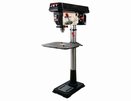How to Remove and Replace Your Drill Press Chuck
 Needless to say, changing the chuck on your drill press it quite a bit different than changing the chuck on, say, your drill-driver. With the right tools and just a few more steps, though, the procedure is no more complicated.
Needless to say, changing the chuck on your drill press it quite a bit different than changing the chuck on, say, your drill-driver. With the right tools and just a few more steps, though, the procedure is no more complicated.
To begin, drill press chucks, mostly due to their specialized taper, are a little bit different than your average drill chuck. The specifically tapered shaft of a drill press chuck is designed to fit firmly into the drill press spindle, which, of course, has an identical taper. This taper, one shared by almost all drill presses and their chuck counterparts, is known as Morse taper which, despite its simplicity, is incredibly efficient maintaining an always firm grip and allowing fast drill bit removal and fitting in a huge array of sizes.
NOTE: Generally, a drill press without Morse taper is a good indication of a bad drill press.
HINT: Remove drill bits from your chuck before attempting to remove it.
CHUCK REMOVAL:
If your drill press chuck wobbles, won’t firmly grip a bit at a perfect vertical, has a bent shaft, or is in some other fashion defective, it needs to be replaced. Using the chuck key or drill chuck removal tool is the simplest and safest way to remove the chuck from your drill press. If, though, for one reason or another, fate has separated you from your chuck key, you can usually purchase one separately, or you can simply cotton to a different, slightly more cave-mannish but equally effective method of removal. This more rudimentary method consists, essentially, of carefully striking the chuck with a piece of scrap wood (or other such soft-ish material that won’t damage the chuck or spindle) and a mallet.
But first – to the chuck key! Lower the quill, or the piece of the drill press that the chuck attaches to, until you have revealed the entirety of a length-wise access window. This window, in effect, is a key-hole in the spindle of the drill press. Insert the chuck key into the window and carefully give it a few whacks with a mallet. This will force the chuck to fall out of the press.
NOTE: Before forcing the chuck out, ensure the height of your drill press table. The table should be raised high enough to catch the chuck before it falls completely out of your spindle while still being low enough to allow the chuck to completely release.
Now, if you don’t have access to your chuck key – let’s get a little cave-man. Place a strong section of scrap wood above the chuck and position it, the wood, at sharp, downward angle. Using a mallet or hammer, simply whack that wood-scrap with a swift downward strike.
NOTE: The wood-scrap need only be thick and wide enough to handle the blow, and long enough to give you sufficient space to whack it – something like ten-inches should be adequate. Additionally, the downward force of the whack ensures you don’t bend or damage the chuck shaft or spindle. As such, it is important your angle is as downward as possible.
The blow should release the chuck on contact. If not, simply ensure the angle and position of your wood-scrap and strike again.
CLEANING:
If a drill press chuck becomes excessively dirty with sawdust, grease, or etc, is not uncommon for it to simply fall right out of your drill press
. In this event, and assuming the chuck hasn’t been significantly damaged in the fall, you need to clean your chuck before reinserting it. In fact, any time you install a chuck into your drill press, new or old, the chuck and press spindle should be thoroughly cleaned.
Using a clean, dry shop-rag, rub a degreasing solution such as acetone or paint thinner around the spindle, or shaft, of the drill chuck. Also clean the inside of the spindle of the drill press to ensure optimal grip and performance.
NOTE: After cleaning, it is important to allow the chuck and spindle to dry before installing.
HINT: After the chuck is clean and dry, you may also want to apply a small amount talcum powder to the chuck’s spindle. Especially if the chuck to be reinstalled is older, this will provide a bit of extra gripping power.
CHUCK INSTALLATION:
After cleaning your chuck and the drill press spindle, the time has now come to install that sparkling chuck. So, with as much concentrated thrust as you can muster, insert the chuck shaft into the spindle. The chuck should remain in the spindle without your help. Retract the chuck’s jaws and lower the press’ table to allow space for some mallet-swinging action. Using your trustee wood (or rubber) mallet, swiftly and forcefully pound the bottom of the chuck deeper into the spindle. Two good whacks should be sufficient force to keep you chuck stuck tight.
If you happen to be a pacifist and find whacking the drill chuck distasteful or otherwise can not complete this step, you may also stack a few pieces of scrap-wood on the drill press table and forcefully, though not aggressively, raise it into the chuck. The upward force of the raised table should push the chuck into place.













